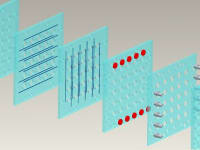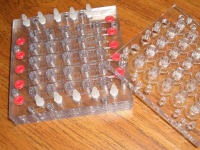
Based upon university research, the electro-less 3D Micro-liter incubator array can be deployed and distributed to organizations in the developing world to mitigate pandemics and accelerate vaccine development in the developed world.
This device overcomes limitations of current designs by harnessing micro-fluidic phenomena to strictly regulate individual cellular culture conditions, work in parallel, and reduce sample volumes, while providing a sealed environmental housing and limiting exposure risks. Specifically, the device allows for 25 to 100 different culture conditions to be investigated simultaneously, while supplying reagent and nutrient delivery in a controllable constant and/or variable manner through the use of mini channels, individual wells to be accessed real-time for the study of both the filtrate and cells separately and hermetically sealed for efficient use highly virulent microorganisms. Combined with a smart phone microscope adapter, images of the micro-cells can be sent to WHO or CDC databases for further identification.
The secondary portion of this platform uses phase change technology, allowing field researchers the ability to incubate samples at 37 degrees C for up to 24 hours. This eliminates bringing additional lab equipment into the field, allowing researchers and medical staff to be more mobile and react faster in identifying solutions to outbreaks.
The device provides an ideal test-bed for studying the dynamical system properties of cellular growth, mutation, and response. The evolution and growth of a cell colony depends strongly on inter-cellular signaling, in which cell-cell contacts act to alter the cell metabolism in order to catalyze further cell attachment and colony growth. In particular, the effects of environmental variables such as temperature, nutrient availability, and metabolite concentrations on the critical threshold are not known. Additionally, the kinetics of the cell attachment at a molecular level may be altered by environmental variables, leading to differences in cell health and cell wall strength and ductility. Studying these behaviors to understand the overall system dynamics and to optimize the environmental conditions is made much easier by a high throughput technique in which many sets of conditions can be examined simultaneously. More importantly aspect of the dynamics of any complex system of interacting cells is time evolution. The population and robustness of a cell colony may depend on the time-history of the cellular environment in non-linear ways.
-
Awards
-
 2013 Top 100 Entries
2013 Top 100 Entries
Like this entry?
-
About the Entrant
- Name:Michael Savoie
- Type of entry:teamTeam members:Corinne Lengsfeld
- Patent status:none





